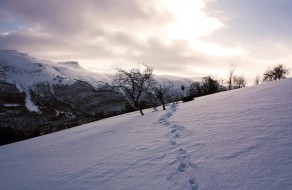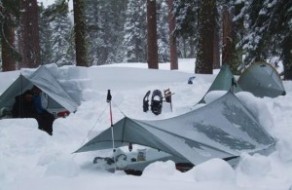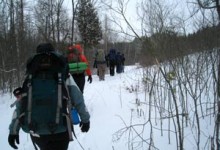Winter Weather Backpacking
Stay warm, dry & safe while backpacking in the coldest conditions
Prepare for the Worst Weather
Before you head out, be sure to check the weather forecast for the area you will be backpacking in. Besides snowy and cold conditions, watch for below freezing temperatures, storms, wind, and cloud cover. Cloudy skies actually make for warmer temperatures, as the clouds keep in the heat. Check with the local rangers or park officials for a more detailed forecast.
Stay Dry and Keep Heat In
Most people who die backpacking in winter die from hypothermia after getting wet, resulting in lower body temperatures. Because of this reason, it is essential to not let snow soak into your clothes and reach your skin. Jeans are the worst at this as they are easily soaked, they keep the moisture in, and they don’t dry quickly. Don’t just bring a rain jacket and expect that to do the job. Remember, it is harder to warm up after getting cold than just staying warm in the first place. Once clothing gets soaked, try any way possible to dry it. At night before going to bed, change into dry clothing and set wet clothes out to dry.
Backpacking Tip:
Layering clothing is also very important in order to trap heat in and insulate your body. However, another mistake many backpackers make is trying to keep in too much body heat. When dress too warmly, your body begins to sweat. Perspiration and moisture will then wet your clothing. Monitor your warmth and remove layers of clothes if you begin to sweat. Avoid clothes that are non-wicking, such as cotton, which don’t let the moisture escape. Instead, wear synthetic fabrics such as polypropylene. Also, always wear a hat and gloves, as these are two areas where most of your body heat escapes.
Eat and Drink Right
Drinking melted snow is highly inefficient, so plan on bringing just as much water while winter backpacking as any spring or fall backpacking trip. Warm liquids will warm you up, but cold water works just as well and keeps you hydrated. Frozen water, however, won’t do you any good. Bring plenty of water, but keep it from freezing. This could mean keeping it inside your coat, in your sleeping bag with you, or in the middle of your backpack.
Food is also a very important part of creating body heat. When you digest food, the calories produce energy and heat. This is why whale blubber is eaten in many arctic areas. Army survival courses teach soldiers to eat large chunks of butter to stay warn in winter conditions. For backpacking purposes, you can have olive oil on your pasta or eat oily foods like corn chips to get the same warming effect.
Winter Shelters
Have a Heat Source
Many backpackers get by with no stove in the warmer months, simply eating cold, dry foods, but in winter a cooking stove is essential. Not only can it provide you with warm food and drinks, it can create enough heat to warm your body in freezing conditions. As stated before, melting snow for drinking water is highly inefficient, but with a stove this is a possible solution to getting water.
Always have enough waterproof matches, a lighter, and other methods to start a fire in case your stove doesn’t work. A fire can easily be a lifesaver if you fall into a stream of lake and need to get warm and dry quick. Read our How to Build a Fire article to learn how to make the perfect backpacking campfire.
More Winter Tricks
Additional Resources
- Wild Backpacker – How to Build a Fire
- Survival Topics – Winter Survival Shelter De-Constructed



